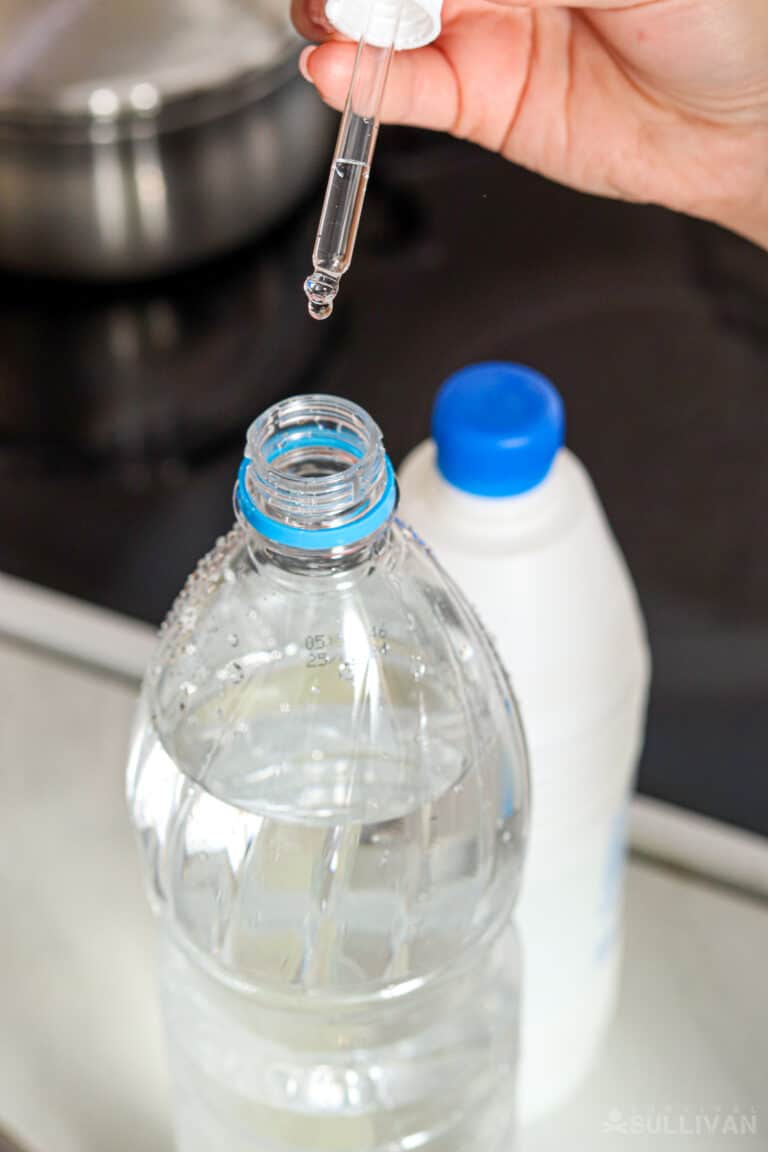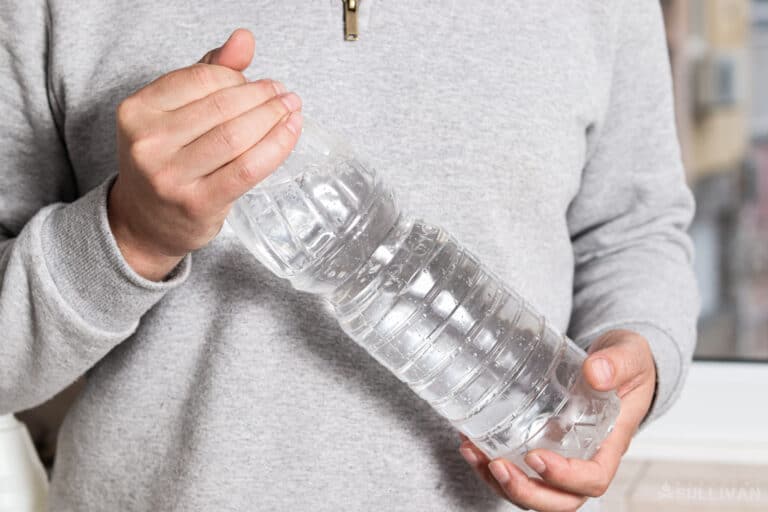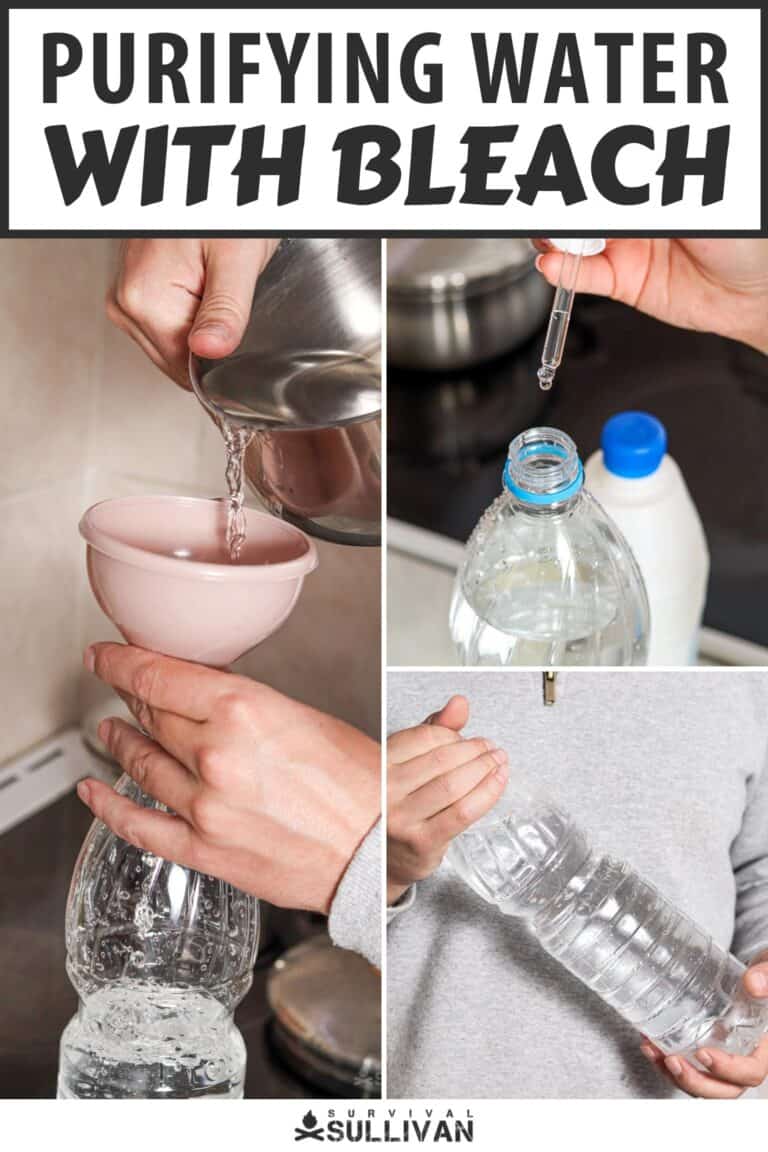In a survival situation, clean water may be hard to come by. If you’re lucky enough to find a natural water source or still have running water, it could be contaminated with bacteria and viruses that could make you terribly sick..

Luckily, you have ways to improve the quality of the water by killing these microorganisms.
Purifying it with bleach is a reliable and easy option. All you need is common household bleach, knowledge of the right ratios, and a little bit of patience.
This guide will show you how to do it step by step, and teach you about possible pitfalls that you should avoid during the process.
Just follow the steps below, and you’ll be able to easily purify questionable water sources using common bleach.
Find a Clean Container
The first step is to find a clean container to purify the water in. This could be a pot, a bottle or even a bowl.
You’ll be working uphill if you add your water to a container that is contaminated with other biological or chemical hazards.
Furthermore, you definitely won’t be doing yourself any favors if you then place your now clean water in a container that is dirty.
Locate clean containers or clean one up before you begin.

Pre-Filter, if Necessary
Once you have your vessel, pre-filter the water if possible. This will remove any large particles that could make the process less effective.
Water that is cloudy or has large, chunky debris floating in it is going to create problems, at the very least making the process take much longer with more repeated applications than it would normally.
Pre-filtering is best done using an actual water filter, but lacking a dedicated filter you can improvise one using coffee filters, multiple stages of crushed charcoal and silt or go really low tech and just use a fine piece of cloth like a bandana.
If you can’t filter the water, don’t worry, you can still try to purify it, it just might take a little longer.

Measure and Fill Water
Next, add the water to your container. Remember that the ratio of bleach to water must be precisely measured to ensure effectiveness and avoid danger, so use any container that holds a known volume, or use accurate measuring cups or other devices to ensure you have the right amount of water in your vessel.
if you don’t have anything that will give you a nice, round volume then use a clean bottle, can or anything else that will get you as close as possible to the prescribed amount.
It is far better to be a little bit off with the quantity of water than risk adding too much or too little bleach when eyeballing it.
Add Bleach to Water
Then, add bleach. The ratio of bleach to water is dependent upon the quantity of water and the strength of your bleach. Is easier to remember how many drops of bleach you should add based on a given quantity of water versus learning a ratio and trying to do the math in your head.

Mix it Up
Once you have added the bleach, you want to stir or agitate the water to make sure it is fully incorporated and distributed.
If your container has a cap or lid, close it and then give the water a good shake. For larger quantities, simply stir the water using any appropriate tool.
Remember, the tool you use should be clean also to avoid adding further contaminants to the water.
Give the Bleach Time to Work
Now, you have to wait. The recommended waiting time for purifying water with bleach is 30 minutes.
This will give the chlorine in the bleach time to kill off any harmful microorganisms in the water. Bleach works quickly but it does not work instantly in this case. After a half-hour has passed, it is time to inspect the results.
Inspect Results
After 30 minutes have passed, inspect the water. If it still smells distinctly like bleach, then the process likely worked and the water is safe to drink. If not, you may need to repeat the process and wait again.
Repeat if Needed
Bleach breaks down in water over time, so you won’t need to worry about bleach accumulating in the water with repeated applications so long as you give it plenty of time to break down once the process is complete.
You should definitely consider a repeat application if, after the first treatment, the water did not smell like bleach or only smelled of it very faintly, or you are dealing with cloudy water that you have no way to filter.
Just make sure you leave a little extra time after the final round of treatment for the bleach to break down and it should be safe to drink.

Mind the Ratios
When using bleach to purify water, it is important to use the correct ratio of bleach to the water.
Using too little means it is unlikely that all of the nasty little germs in the water will perish while using too much can harm you or your family, potentially seriously.
To purify water with bleach safely and effectively, follow these ratios:
Quart of Water
Use 2 drops of bleach per quart of water whether you are using 8.25% bleach or 6% bleach.
Gallon of Water
Use 6 drops of bleach for every gallon of water if using 8.25% concentration, or 8 drops of bleach per gallon if using 6% concentration.
2 Gallons of Water
You use 12 drops of 8.25% bleach for every 2 gallons of water, or 16 drops of bleach if using 6%.
5 Gallons of Water
Add 30 drops of 8.25% bleach to every 5 gallons of water, or 40 drops of 6% bleach to every 5 gallons.
What Kind of Bleach to Use for Purifying Water
There is only one kind of bleach that can be used for purifying water: sodium hypochlorite or “chlorine” bleach.
Chlorine bleach is the most common and effective type of bleach for purifying water. Non-chlorine bleaches are not as effective and more likely to be toxic.
This means you need only regular, common, standard household bleach for the purpose, the same kind you can buy at any grocery or hardware store.
Common concentrations are 6% and 8.25%, with the latter becoming the standard over time, it seems.
Remember: the concentration of the bleach will affect the amount you add to a given quantity of water, so always double-check it!
Don’t Use Any of the Following Bleaches
When I say you only need to use regular, plain bleach, I mean just that. Do not use scented bleaches, color-safe bleaches, splashless or “oxygen” types of bleaches (e.g. Oxi-Clean).
These are not effective for purifying water and some of them may actually be harmful all on their own, even in small quantities.
So, what about those new gel packs or tablet forms of bleach? Unfortunately, they’re also not effective for purifying water.
If you want to use bleach to purify water, stick with the plain liquid form of sodium hypochlorite.
Sodium hypochlorite is the only type of bleach that can be used to reliably and safely purify water. Non-chlorine bleaches or chlorine bleach with any additives are not as effective and unsafe.
If you resort to any of the above types of bleach, you may not purify the water, or else you will kill the germs but poison yourself with other harmful chemicals.
Either way, you’ll end up harming yourself in the process. So, again, only use regular, plain liquid chlorine bleach to purify water.

Stored Bleach Loses its Potency over Time
Bleach is definitely an asset in your survival stockpile, and there is hardly anything that works better, quicker and more reliably when it comes to purifying water of biological contaminants.
However, bleach does have something of an Achilles heel and that is its relatively short shelf life.
Yes, bleach does have a shelf life even though it technically does not spoil. You can only expect a new, sealed bottle of sodium hypochlorite bleach to last anywhere from 5 to 6 months before the active ingredients start to lose their potency.
In fact, it is possible for a brand new jug of bleach to lose nearly half of its effectiveness in just one year.
Given enough time, sodium hypochlorite bleach will chemically break down into salt water, and nothing more. Once this happens, it is no longer useful or viable for treating your water.
What’s worse, bleach that has been opened will degrade more quickly, as will bleach that is stored in extreme temperatures, either hot or cold.
Maximizing the shelf life of your stored bleach is a matter of keeping the container sealed and stashing it between 50 and 70 degrees Fahrenheit.
For that reason, you generally won’t want to store it inside a hot and stuffy laundry room where you have your dryer running. Keep it in a cool, dry place along with other essential survival supplies.
Bleach Will Not Remove All Contaminants from Your Water
It should be pointed out, for clarity, that bleach is only effective against biological contaminants in drinking water.
Bacteria, viruses and the like will be readily destroyed by bleach, assuming the water is reasonably clear, but other chemical contamination and things like heavy metals will not be affected at all.
Accordingly, bleach might not be the best choice for treating water that has likely been contaminated by either or both of the latter threats.
This makes bleach a great option for treating tap water that might be contaminated in the aftermath of a disaster, or natural water sources that are unlikely to have been contaminated with anything but biological matter.
In any case, bleach is extremely valuable when used in conjunction with an effective water filter that might not catch the smallest biological threats.
Field Expedient Methods for Precisely Measuring Bleach
As you no doubt noticed when reading the above procedures, it is vital that you precisely measure a small quantity of bleach, of any concentration, for adding to your gathered water for treatment.
This necessitates the use of a dropper, pipette or some other similar tool in order to meter out the bleach.
Unfortunately, either might be missing, broken or generally in short supply when you need to add the bleach to your water.
Lacking either of these tools or something similar, you need not panic because it is possible to improvise a dropper from common items.
One method that is entirely viable when it treating larger quantities of water is to figure out how many drops of water go into a teaspoon or tablespoon measure.
When treating a large quantity of water, a single drop difference one way or the other is unlikely to cause any harm.
Alternately, you can make a dropper by grabbing a spoon and then using a thin strip of paper or heavy cloth in conjunction with it.
Simply scoop up some bleach with the spoon, and then lay the strip of paper or cloth in the bowl, allowing it to wick the bleach up and out into the free end or gravity will allow it to form a drop and then fall. Nothing to it, now you can count the drops of bleach easily!
Bleach Purification is a Vital Tool in a Prepper’s Toolbox
Common household bleach is a simple and reliable method for purifying water that might be biologically contaminated.
Using minimal preparation and easy procedures, bleach can make suspect or collected water far safer to drink in the aftermath of a disaster or during any other survival scenario.
Keeping a quantity of bleach on hand for this purpose is a great way to improve your drinking water supply chain.

The post Purifying Water with Bleach Step by Step appeared first on Survival Sullivan.
By: Tom Marlowe
Title: Purifying Water with Bleach Step by Step
Sourced From: www.survivalsullivan.com/purifying-water-with-bleach/
Published Date: Mon, 20 Jun 2022 11:02:40 +0000
-------------------------------------------------------------------------
Did you miss our previous article...
https://outdoorsnewswire.com/survivalist/book-review-the-disaster-diaries-by-sam-sheridan
 CampingSurvivalistHuntingFishingExploringHikingPrivacy PolicyTerms And Conditions
CampingSurvivalistHuntingFishingExploringHikingPrivacy PolicyTerms And Conditions
